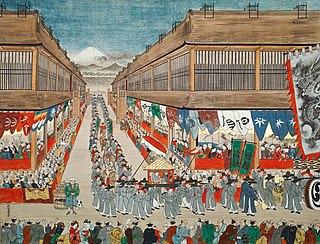Related Research Articles

Ashikaga Yoshimochi was the 4th shōgun of the Ashikaga shogunate who reigned from 1394 to 1423 during the Muromachi period of Japan. Yoshimochi was the son of the third shōgun Ashikaga Yoshimitsu.

Ōei (応永) was a Japanese era name after Meitoku and before Shōchō. This period spanned the years from July 1394 through April 1428. Reigning emperors were Go-Komatsu-tennō (後小松天皇,) and Shōkō-tennō (称光天皇).

The Joseon Tongsinsa were goodwill missions sent intermittently, at the request of the resident Japanese authority, by Joseon Dynasty Korea to Japan. The Korean noun identifies a specific type of diplomatic delegation and its chief envoys. From the Joseon diplomatic perspective, the formal description of a mission as a tongsinsa signified that relations were largely "normalized," as opposed to missions that were not called tongsinsa.
Yeo U-gil (1567-1632) was a scholar-official of the Joseon Dynasty Korea.
Hwang Yun-gil, also known as Hwang Yun'gil, was a Korean diplomat and ambassador. He was a member of the Western faction in the Joseon court. He represented Joseon interests in a tongsinsa to Sengoku period in Japan when it was controlled by strongman Toyotomi Hideyoshi.
Byeon Hyo-mun (1396–?) was a Korean civil minister (munsin) from the Chogye Byeon clan during the early period of Korean Joseon Dynasty. He briefly served as a diplomat and an ambassador, representing Joseon interests in the Tongsinsa to the Ashikaga shogunate in Japan.
Song Hui-gyeong (1376–1446) was a scholar-official of the Joseon Dynasty Korea in the 15th century.
Bak Don-ji was a Korean scholar-bureaucrat, diplomat and ambassador, representing Joseon interests in the tongsinsa to the Ashikaga shogunate in Japan.
Bak Seo-saeng (?-?) was a Korean civil minister (munsin) in the 15th century during the early period of the Korean Joseon Dynasty (1392–1897). Bak was also diplomat and ambassador, representing Joseon interests in the Tongsinsa to the Ashikaga shogunate in Japan.
Go Deuk-jong (1388-1452) was a scholar-official of the Joseon Dynasty Korea in the 14th century.
Yang Su was a Korean diplomat and ambassador, representing Joseon interests in a diplomatic mission to the Ashikaga shogunate in Japan.

Joseon missions to Japan represent a crucial aspect of the international relations of mutual Joseon-Japanese contacts and communication. In sum, these serial diplomatic ventures illustrate the persistence of Joseon's kyorin diplomacy from 1392 to 1910.
Bak Hui-jung (1364–?) was a scholar-official of the Joseon Dynasty Korea in 14th and 15th centuries.
Hwang Sin (1560–1617) was an officer of the Joseon Dynasty Korea in 16th and 17th centuries. In 1588, Hwang placed first in the final civil service examination (Mungwa).
Yeo Ui-son was a Korean civil minister (munsin) and diplomat from the Hamyang Yeo clan during the early period of the Joseon dynasty. Yeo served as the first governor (moksa) of the Jeju Island and a Jeonseo (minister). He also was sent to Japan as a diplomat representing Joseon.
Bak An-sin (1369–1447) was a scholar-official of the Joseon Dynasty Korea in the 15th century.
Joseon missions to Imperial China were Joseon diplomatic ventures which were intermittently sent in the years 1392-1894. These represent a significant aspect of the international relations of mutual Korean-Chinese contacts and communication.
Joseon diplomacy was the foreign policy of the Joseon Dynasty of Korea from 1392 through 1910; and its theoretical and functional foundations were rooted in Neo-Confucian scholar-bureaucrats, institutions and philosophy.
Japanese missions to Joseon represent a crucial aspect of the international relations of mutual Joseon-Japan contacts and communication. The bilateral exchanges were intermittent.
Japanese missions to Silla represent an aspect of the international relations of mutual Silla-Japanese contacts and communication. The bilateral exchanges were intermittent.
References
- Daehwan, Noh. "The Eclectic Development of Neo-Confucianism and Statecraft from the 18th to the 19th Century," Korea Journal (Winter 2003).
- Kang, Etsuko Hae-jin. (1997). Diplomacy and Ideology in Japanese-Korean Relations: from the Fifteenth to the Eighteenth Century. Basingstoke, Hampshire; Macmillan. ISBN 978-0-312-17370-8; OCLC 243874305